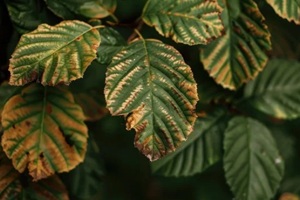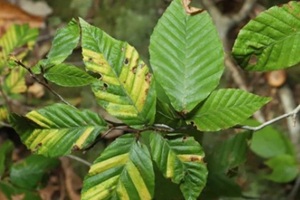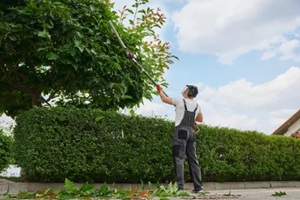
Virginia’s forests are experiencing a growing threat that’s quietly spreading through the Commonwealth’s woodlands. Beech leaf disease, first confirmed in Virginia in 2021, poses serious risks to one of our region’s most important native tree species. This emerging disease has already altered forest ecosystems across the Eastern United States and continues to expand its range southward.
This article will detail everything you need to know to protect your trees on your property from beech leaf disease.
Understanding Beech Leaf Disease
Beech leaf disease affects American beech trees (Fagus grandifolia), a species that forms the backbone of many forests in Virginia. The disease is caused by a microscopic nematode called Litylenchus crenatae mccannii, which specifically targets beech foliage and buds.
The Virginia Department of Forestry confirmed the disease’s presence in Prince William County in August 2021, marking its first detection in the state. According to mapping data as of December 2024, the disease has spread north into Michigan, Canada, and Maine, as well as south into Virginia.
Recognizing the Symptoms
Property owners should watch for several distinct symptoms that indicate beech leaf disease infection. The most noticeable signs appear on the foliage during the growing season.
Symptoms include:
- Dark stripes running parallel between veins
- Thickening and curling of leaves
- Canopy thinning as branches die back
- Leaves appearing smaller than normal
These dark bands create a distinctive striped pattern that differentiates this disease from other beech problems. The leaf symptoms often progress over time, with infected trees experiencing significant canopy reduction from repeated defoliation.
How the Disease Spreads
The nematode spends the winter in infected buds and emerges in late winter or early spring when eggs are laid. Wind can carry them short distances, while human activities like moving infected plant material can transport them longer distances. The nematodes also survive on tools and equipment, but proper sanitation practices can help stop the spread.
The nematode only infects beech species and is limited to the leaf and leaf bud tissue, with no evidence of infection in beech tree roots, trunks, or other woody tissue. This makes early detection and treatment essential for preserving tree health.

Impact on Virginia’s Forests
The implications extend far beyond individual trees. Beech trees constitute a considerable portion of eastern trees making the beechnuts they produce a valuable food resource for wildlife animals in the region. As such, beech leaf disease has the potential to significantly damage the whole of the eastern forest.
For homeowners in Virginia with valuable properties, losing mature beech trees represents both ecological and financial losses. The disease has been confirmed in Burke Lake, Fountainhead, Hemlock Overlook, Pohick Creek Stream Valley Parks, and around Lake Mercer.
Current Treatment Options
While researchers continue working toward better solutions, several treatment approaches show promise. At this time, two chemical treatments are available in Virginia: one is a trunk injection treatment, and the other is a foliar treatment, both of which should only be applied by licensed pesticide applicators.
Professional arborists have access to systemic treatments that can help reduce nematode populations. Research indicates timing is essential for treatment effectiveness. Early-season applications of fluopyram may be the most effective in controlling BLD. For the best results, applications should be made once leaves are fully formed in June and July.
Prevention and Early Detection
Property owners can take several steps to protect their beech trees:
- Regular monitoring during the growing season allows for early detection when treatments are most effective.
- Strategic pruning to reduce moisture in the tree canopy is recommended, especially before fall when the nematodes spread.
- Proper sanitation practices become particularly important when working around beech trees. As such, tools and equipment should be cleaned between trees to prevent accidentally spreading nematodes.
Professional tree care companies understand these protocols and have the necessary equipment for safe handling.
Partner With RTEC Treecare for Thorough Beech Tree Protection
Virginia property owners don’t have to deal with beech leaf disease alone. RTEC Treecare combines expert arborist knowledge with environmentally responsible treatment approaches to protect your valuable beech trees from this emerging threat.
Our certified arborists understand the complexities of beech leaf disease management and have access to the most up-to-date treatment protocols. We provide thorough assessments, customized treatment plans, and ongoing monitoring to give your trees the best chance of remaining healthy despite disease pressure.

As a Tree Care Industry Association (TCIA) accredited company with International Society of Arboriculture (ISA) certified arborists, RTEC Treecare brings proven expertise to every project. Our preservation-based approach focuses on long-term tree health rather than short-term fixes, guaranteeing that your landscape investment remains protected for years to come.
Call RTEC Treecare at (571) 506-6140 or contact us online to schedule a professional assessment of your beech trees. Early detection and treatment provide the best outcomes, and our team is ready to help you develop a complete protection strategy customized to your property’s specific needs.


